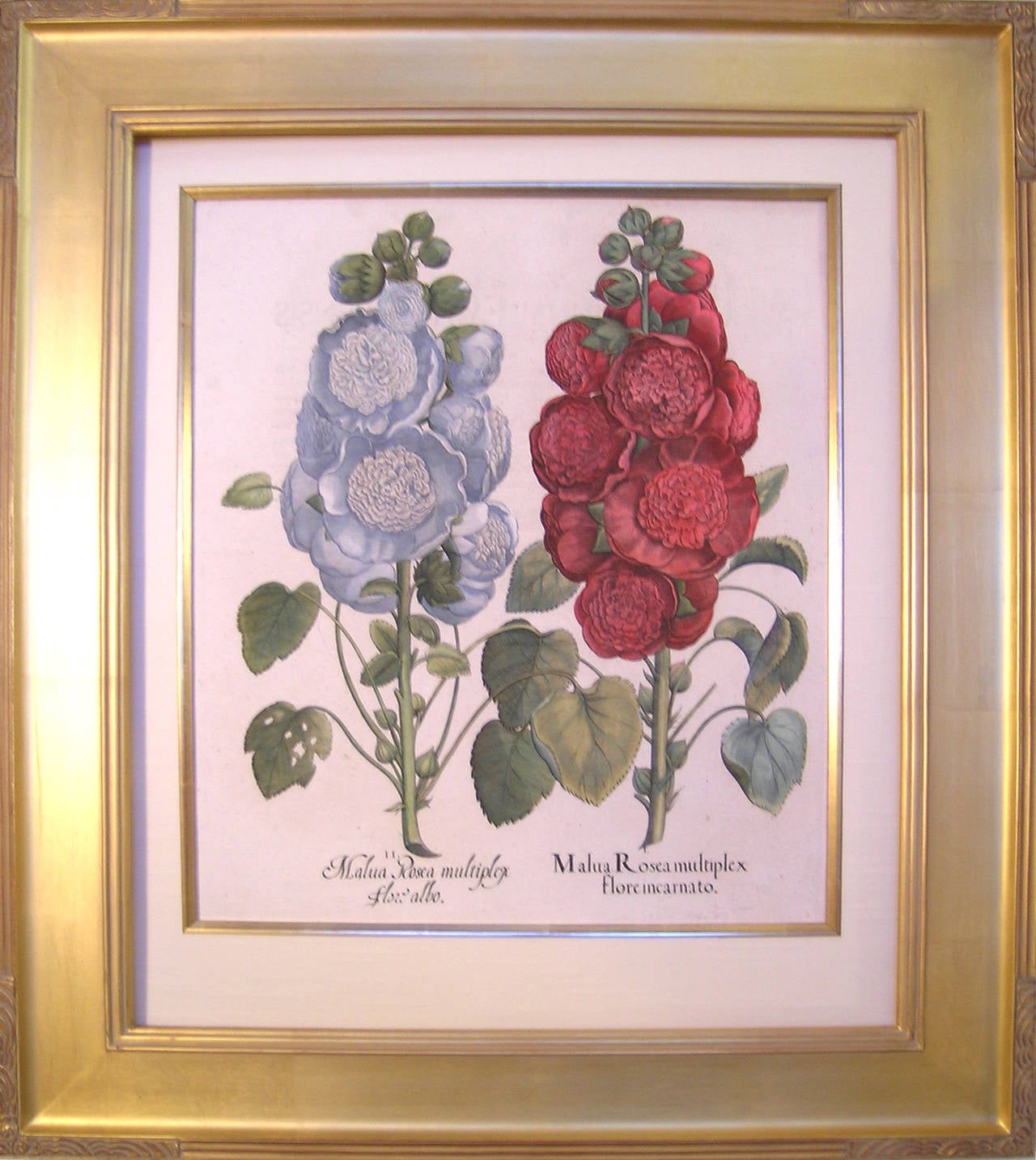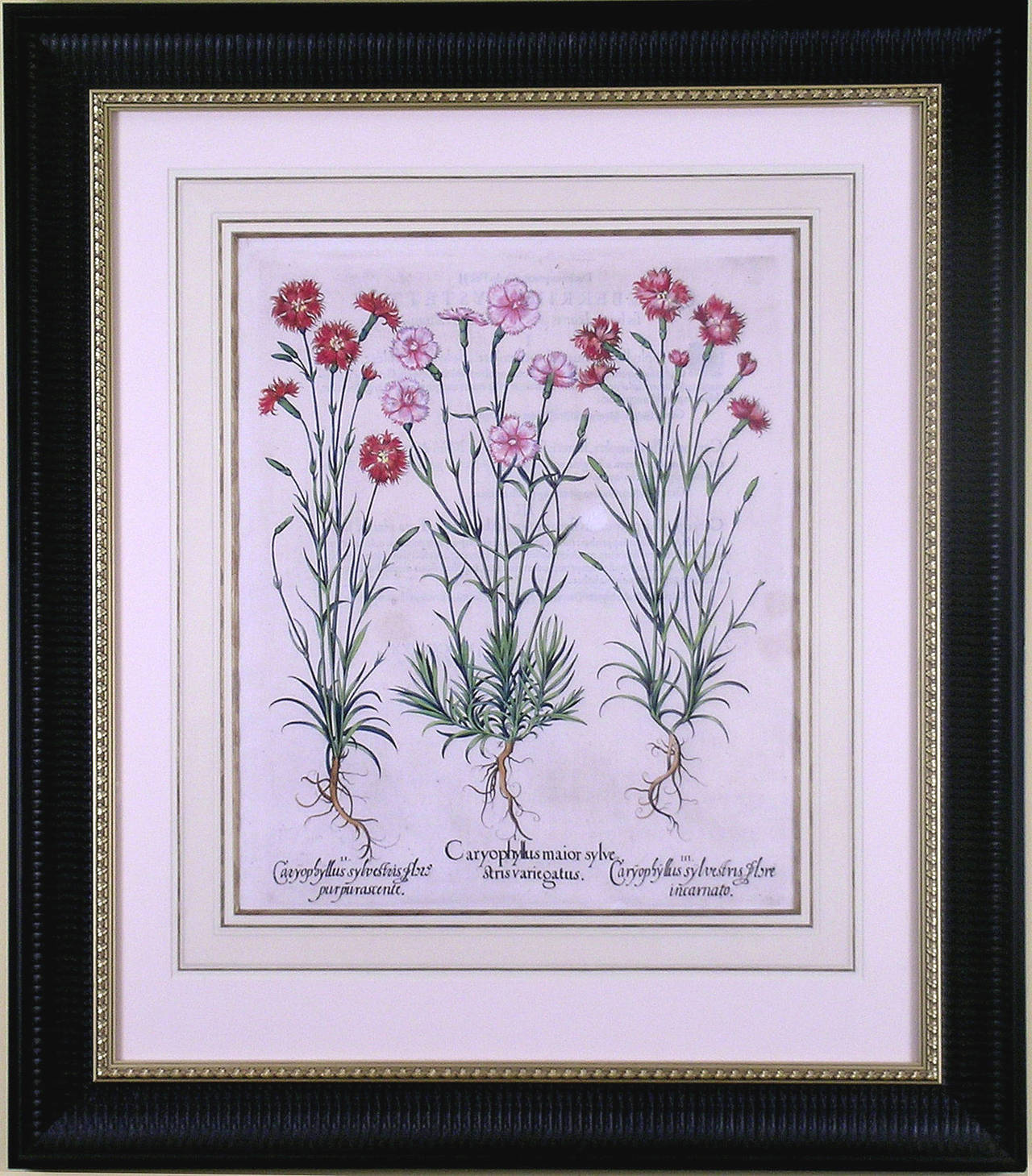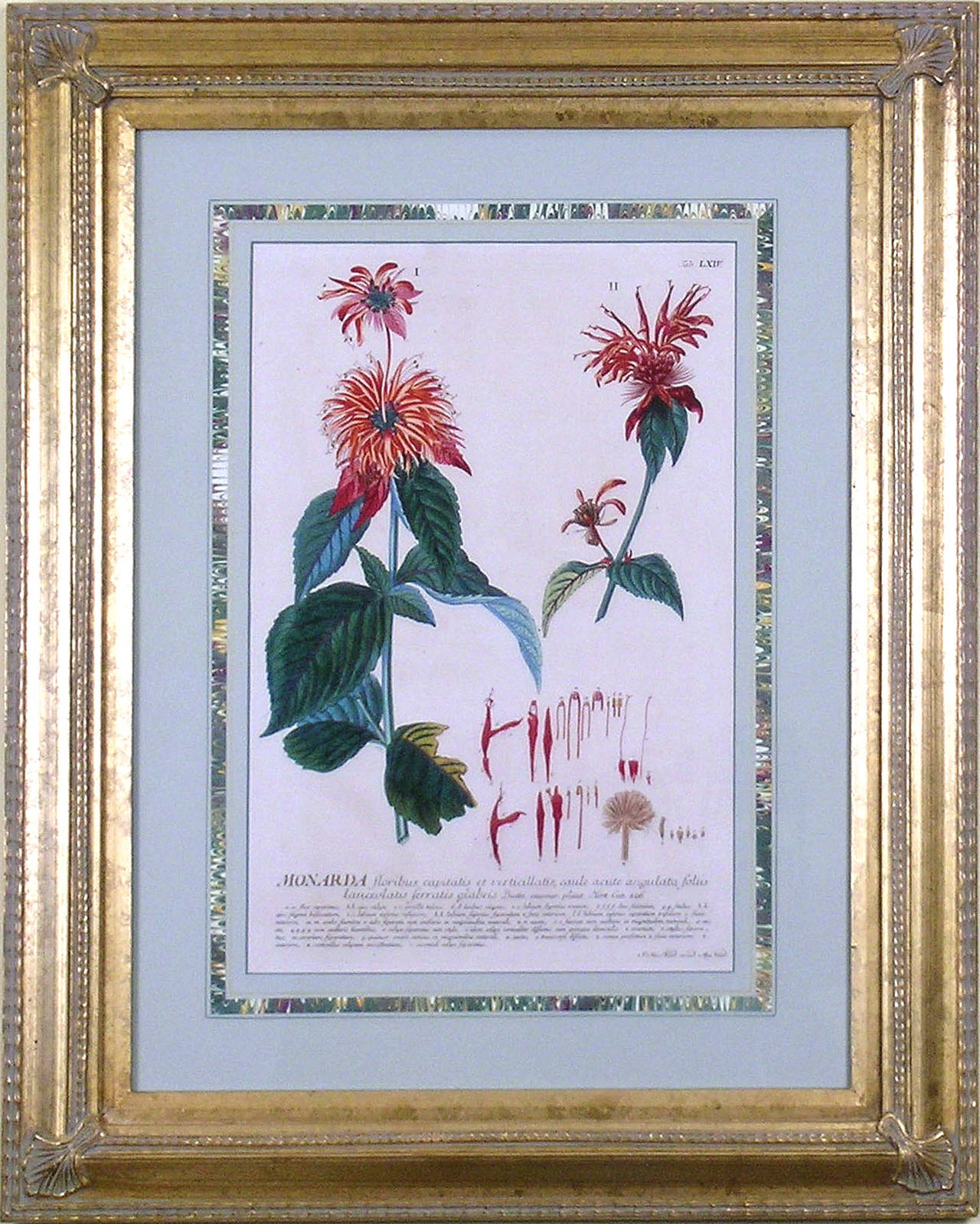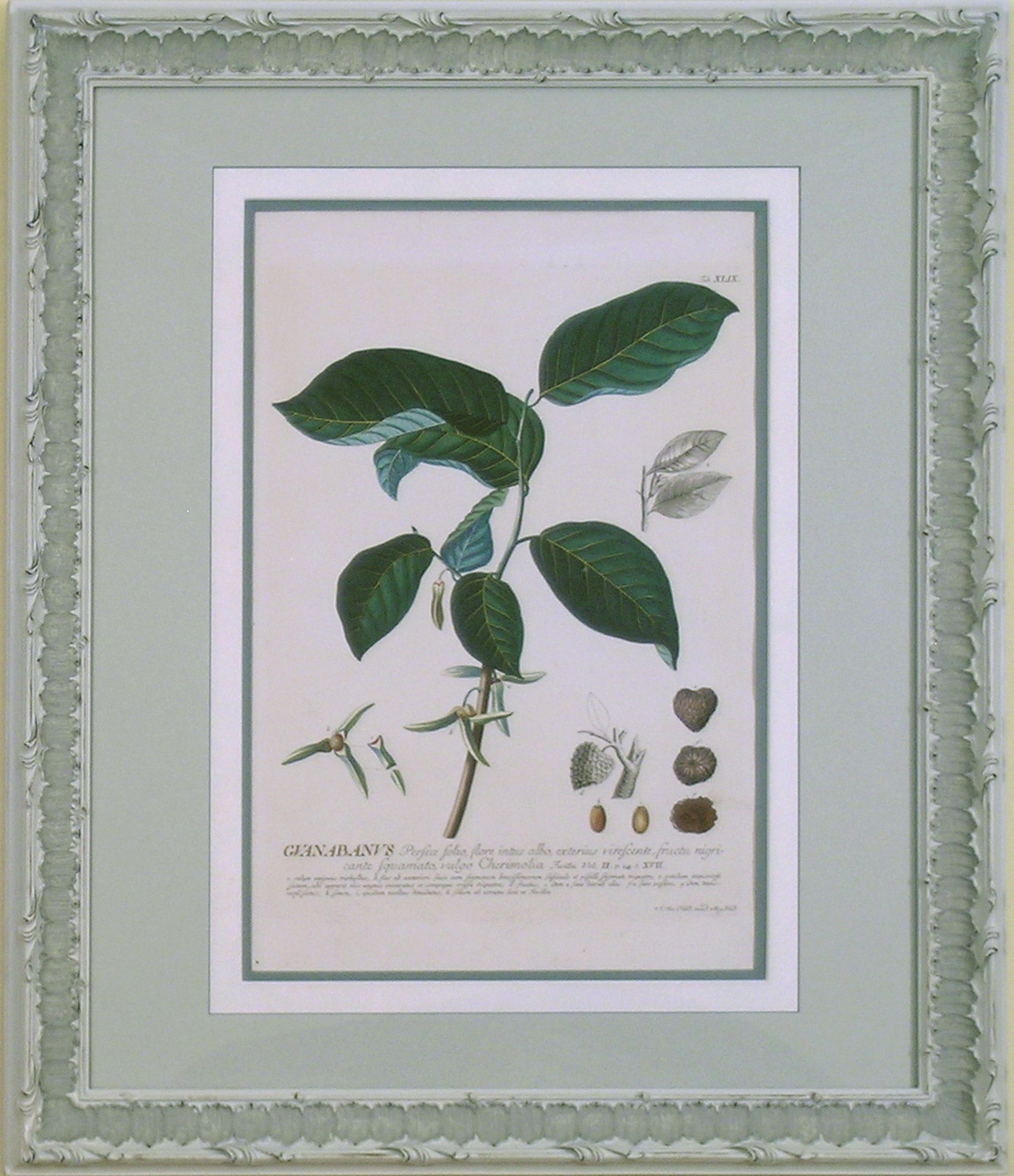Items Similar to Oblique-leaved Begonia
Want more images or videos?
Request additional images or videos from the seller
1 of 7
Dr. Robert John ThorntonOblique-leaved Begonia1800
1800
About the Item
This piece would pair well with Thornton's "Hyacinths" which is also listed.
DR. ROBERT JOHN THORNTON (c1765 – 1832).
The Temple of Flora.
London, 1798-1810.
Painted by Reinagle, Henderson, Pether, et. al.
Engraved by Ward, Caldwall, Earlom, et. al.
Aquatint, mezzotint, and/or stipple engraving finished by hand.
Approximately 17.75” x 22.5” Unframed.
5 frontice pieces, 32 plates; generally 29-30 per volume, 1 or more frontice pieces.
As a boy, Robert John Thornton (d.1837) demonstrated his love of natural history with his own botanical garden and an aviary, which contained every species of English hawk, most of them captured by himself. He took his Cambridge M.B. and, following in his father's footsteps, set up practice as a London doctor. Upon inheriting the family fortune in 1797, Thornton desired to leave his mark on the world in the form of a massive work dedicated to Carolus Von Linnaeus, the great Swedish naturalist. For his own aggrandizement and that of his beloved England, Thornton wished it to surpass in scope, illustration, paper, and topography any publication produced in any other European country. He felt he was engaged upon "a national undertaking", and dedicated this homage of philosophic and literary distinction to Queen Charlotte. It was to be titled The Temple of Flora; or Garden of Nature Picturesque Botanical Plates of the New Illustration of the Sexual System of Linnaeus. Desiring the national glorification of botany and its alliance with the arts of painting and engraving, Thornton was the first person to juxtapose landscape backgrounds with his floral subjects. He opened an art gallery of the paintings from which the prints were made and subscriptions for the forthcoming books were sold. Copies of the work were sent to the Queen and Prince Regent, and to the Emperor of Russia, who sent Thornton a ring in acknowledgment of the "splendid and elaborate Botanical works."
The Thornton prints, originally to number seventy in all, were barely published in an edition of thirty at the author's expense between the years 1799 and 1807. Despite his efforts, Thornton was unable to succeed financially. Technically The Temple of Flora, as it came to be known, was not a success due to botanical inaccuracies and rather insipid text all based on Thornton's aesthetic sense. However, it is the forceful stylization of flowers, together with their historical, allegorical and fanciful backgrounds that place The Temple of Flora among the greatest botanical books of all time.
Though Thornton actually painted only one picture used for the engravings in his Temple, "The Roses", he literally directed his flower pictures. He chose the plants, arranged the symbolism and the backgrounds. For example, in the "Night-Blowing Cereus" the moon illuminates the turret clock, which has just struck midnight, the hour when this flower is fully open. Henderson, Reingal, Edwards and Pether are among the artists hired by Thornton to work on the flower designs and their backgrounds. Many times they would collaborate, as in the aforementioned "Cereus" where it states "The Flower by Reinagel, Moonlight by Pether". These plates were executed by the likes of Bartolozzi and other English master engravers and are a varied combination of mezzotint, aquatint, stipple engraving and finished in watercolor by hand. The text, primarily composed by Thornton, was lengthy, somewhat fanciful and included rather exaggerated poetry. Thornton was a man of his era, a time of romanticism, when artistic tastes ran to the sentimental, symbolic, and dramatic. The flowers from the Temple of Flora are delightful examples of that style.
In spite of tremendous public exposure and a dedication to Queen Charlotte, Thornton's venture was a financial disaster. While he attributed this to the continental war, no doubt his over-zealous attention to details, none too scientific, largely contributed to his failure. By 1811, Thornton was forced to petition Parliament for permission to set up a lottery. "An Act to enable Dr. Robert John Thornton to dispose of his collection of paintings, drawings and engravings, together with several copies of certain books therein mentioned, by way of chance" was passed in May of that year. Thus, the Quarto or Lottery edition of The Temple of Flora was published. This work, smaller in scale but not in romantic spirit, was to salvage Thornton's expenses for the original folio edition. Hoping to sell twenty thousand tickets at two guineas each, Thornton estimated the worth of his ten thousand prizes to be 77,000 pounds. This was a generous estimate as the complete sale of tickets would be worth no more than 42,000 pounds. Once again, Thornton's venture resulted in disaster. For the remaining years of his life, Thornton continued his medical practice with varying success, and attempted a brief, unhappy collaboration with the poet William Blake. Sadly when he died in 1837 his family was almost destitute. But despite these early failures, The Temple of Flora has now a permanent place as one of the greatest prizes of all time.
Reference:
Flower & Fruit Prints. Dunthorne. Da Capo Press. Washington, D. C., 1938.
The Temple of Flora: Robert Thornton. King. Little, Brown and Company, NY, 1981.
- Creator:Dr. Robert John Thornton (1768 - 1837, English)
- Creation Year:1800
- Dimensions:Height: 37 in (93.98 cm)Width: 31 in (78.74 cm)Depth: 1.5 in (3.81 cm)
- Medium:
- Movement & Style:
- Period:
- Condition:Clean, crisp image. Full margins. Beautiful original color finished by hand. Custom hand-painted frame.
- Gallery Location:Florham Park, NJ
- Reference Number:
Dr. Robert John Thornton
Robert John Thornton (1765-1832) was attracted to natural history at an early edge and created his own botanical garden and an aviary as a boy. He graduated from Cambridge with a medical degree and set up practice as a London. He inherited his family fortune in 1797, which allowed Thornton the opportunity to devote time to his lifelong goal of creating an extensive scholarly work dedicated to the great classical Swedish naturalist, Carolus Von Linnaeus (1707-1778), also known as Carl von Linné, who developed a system for the classification of plants and animals, and is known as the father of taxonomy. Thornton's goal was to exceed any previous publication produced in any European country in terms of the scope of the project, the quality of the illustrations and the paper, as well as the beauty of the landscapes depicted as backgrounds for the plants. Thornton was the first person to incorporate landscape backgrounds with his botanical subjects. He wanted for the publication to be of both academic importance as well as artistic beauty. He dedicated his work and subsequent publication "The Temple of Flora; or Garden of Nature Picturesque Botanical Plates of the New Illustration of the Sexual System of Linnaeus" to Queen Charlotte. Thornton opened an art gallery to display the paintings from which the prints were made and as a place to sell subscriptions to the forthcoming books. Queen Charlotte, the Prince Regent, and the Emperor of Russia received copies of the book. Although the publication was not successful financially for Thornton, the stylization of the illustrated flowers and their historical, allegorical and fanciful backgrounds led to The Temple of Flora being considered one of the greatest botanical books of all time.
About the Seller
5.0
Vetted Seller
These experienced sellers undergo a comprehensive evaluation by our team of in-house experts.
1stDibs seller since 2014
161 sales on 1stDibs
Typical response time: 2 hours
- ShippingRetrieving quote...Ships From: Florham Park, NJ
- Return PolicyA return for this item may be initiated within 1 day of delivery.
More From This SellerView All
- Malva Rosea (Hollyhock, Mallow)By Basilius BeslerLocated in Florham Park, NJThis piece would pair well with Basil Besler's "Malva hortensis flore..." which is also listed BASIL BESLER (1561 – 1629). Hortus Eystettensis. Konrad ...Category
18th Century and Earlier Academic Prints and Multiples
MaterialsArchival Paper, Watercolor, Archival Tape, Gesso, Handmade Paper, Laid P...
- Malva hortensis flore... (Hollyhock, Mallow)By Basilius BeslerLocated in Florham Park, NJThis piece would pair well with Basil Besler's "Malva Rose" which is also listed. BASIL BESLER (1561 – 1629). Hortus Eystettensis. Konrad Bauer. Altdo...Category
18th Century and Earlier Academic Prints and Multiples
MaterialsSilk, Archival Paper, Archival Tape, Gesso, Handmade Paper, Laid Paper, ...
- Purple Grapes.By Maria Sibylla MerianLocated in Florham Park, NJThis piece would pair well with Maria Sibylla Merian's "Green Grapes; which is also listed. MARIA SIBYLLA MERIAN (1647-1717) Metamorphosis Insectorum Surinamensium… (Insects of Su...Category
18th Century and Earlier Academic Prints and Multiples
MaterialsSilk, Archival Paper, Archival Tape, Gesso, Handmade Paper, Laid Paper, ...
- Caryophyllus Flore (Carnations)By Basilius BeslerLocated in Florham Park, NJThis image would pair well with Besler's "Caryophyllus Major" which is also listed. BASIL BESLER (1561 – 1629). Hortus Eystettensis. Konrad Bauer. Altdorf, 1613, 1640, 1713 – 50....Category
18th Century and Earlier Academic Prints and Multiples
MaterialsWatercolor, Archival Paper, Archival Tape, Handmade Paper, Laid Paper, P...
- Monarda (aka Bee Balm, Bergamot)By Georg Dionysius EhretLocated in Florham Park, NJGEORGE DIONSYSIUS EHRET (1708-1770). Plantae Selectae.... Text by Dr. Christoph Trew. Drawn by Georg Dionsysius Ehret. Engraved by Johannes Jacobus and Johannes Elias Haid. Nure...Category
18th Century and Earlier Academic Prints and Multiples
MaterialsGold Leaf
- Guanabanus (Guabana or Soursop Fruit)By Georg Dionysius EhretLocated in Florham Park, NJGEORGE DIONSYSIUS EHRET (1708-1770). Plantae Selectae.... Text by Dr. Christoph Trew. Drawn by Georg Dionsysius Ehret. Engraved by Johannes Jacobus and Johannes Elias Haid. Nuremberg, 1750-73. Hand-colored engravings. Titles highlighted with goldleaf. 100 plates. 19.5” x 13.5” Unframed. A supplement of 20 plates issued by B.C. Vogel in 1790. "The dominant influence in botanical art during the middle years of the 18th century." "One of the finest records of cultivated flowers..." "His accuracy and general excellence as a true botanical artist have never been equaled." Ehret’s praises have been sung throughout the centuries. While his training was in gardening, Ehret's true talents were in his art. Drawing the specimens from life in the garden's in which he labored won Ehret his employer's praise and his co-workers jealousy. Not only were his botanical portraits highly accurate in every technical detail, they reflected an awe-inspiring love of subject. A restless man, Ehret wandered from Heidelberg through Germany to Vienna and Basle, working his way to Paris and finally settling in London. He was honored by peers and patrons wherever he traveled. Ehret's list of benefactors include the most brilliant and generous members of society in his day. However, it was Christoph Trew, a wealthy physician, lifelong supporter and friend, who published the work for which Ehret is best known, Plantae Selectae. Ehret went to Leiden to meet Carolus Linnaeus and they became the best of friends. It is the Linnaen classification of plants to which Ehret subscribed. In distinguishing of the sexual systems of plants and the cross-sectioning of specimens, based on the teachings of Linnaeus, Ehret's illustrations have become the standard followed by horticulturists throughout the centuries. Ehret is the only foreigner to be elected a Fellow of the Royal Society in England. The illustrations for Plantae Selectae were printed in black and white and painstaking colored by hand at the time of publication. The color is superb! All of the initial words of the titles were gilded; a glorious tribute to an achievement of excellence. Various scholars at the time of publication praised the book highly, singling out the excellent quality of Ehret's watercolor studies, as well as Haid's fidelity to them. In a letter to Linnaeus in the 1750's, Dr. Trew called the book "one of the miracles of our century in the natural sciences." In the 1960's, Claus Nissen wrote "the Plantae Selectae became the most beautiful German plant...Category
1750s Academic Prints and Multiples
MaterialsGold Leaf
You May Also Like
- Color-Blast BouquetBy Dionisios FragiasLocated in New York, NYDionisios Fragias is a New York -based artist born on the Greek island of Kefalonia and raised in New York City. He is the protege of the artist Jeff Koons whose years-long mentorshi...Category
2010s Abstract Abstract Prints
MaterialsArchival Tape, Archival Ink, Archival Paper, Color, Archival Pigment
- Eagle /// Antique Ornithology Bird Saverio Manetti Italian Watercolor EngravingBy Saverio ManettiLocated in Saint Augustine, FLArtist: Saverio Manetti (Italian, 1723-1785) Title: "Eagle" (Plate V - 5) Portfolio: Storia Naturale Degli Uccelli (The Natural History of Birds) Year: 1767-1776 Medium: Original Hand-Colored Engraving on watermarked laid paper Limited edition: Unknown Printer: Unknown Publisher: heirs of Francesco Mouck (Vols. I-III), Gaetano Cambiagi (Vol. IV), Giuseppe Vanni (Vol. V), Florence, Italy Sheet size: 16.75" x 14.5" Platemark size: 13.63" x 10.88" Condition: Some minor surface marks mainly in margins. In excellent condition with strong colors Rare Notes: Provenance: private collection - Haarlem, Netherlands. Engraved and hand-colored by Italian artists Lorenzo Lorenzi (Active: 1750-1780) and Violante Vanni (1732-1776). Latin and Italian texts by Saverio Manetti. Comes from Manetti's monumental 5 book volume "Storia Naturale Degli Uccelli (The Natural History of Birds)", (1767-1776), which consists of 600 hand-colored prints, miniature and life-size prints, made from engraved plates. Unidentified watermark in very center of sheet. Comes with its accompanying information sheet. Eagle is the common name for many large birds of prey of the family Accipitridae. Eagles belong to several groups of genera, some of which are closely related. Most of the 60 species of eagle are from Eurasia and Africa. Manetti's extraordinary "Storia Naturale Degli Uccelli (The Natural History of Birds)", 1767-1776 was commissioned by Maria Luisa, the Grand Duchess of Tuscany. It is a massive 5 book volume set...Category
1770s Old Masters Animal Prints
MaterialsIntaglio, Laid Paper, Handmade Paper, Watercolor, Engraving
- Union - Whom --- Has Join'd, Let No Man put Asunder!Located in Middletown, NYEtching and engraving with hand coloring in watercolor on cream laid paper. 6 3/4 X 9 5/8 inches (170 x 244 mm), margins trimmed, image intact. Rubbing in the lower left image area obscuring the publishing information (which reads Published by Mm. Darchery, St. James Street March 11, 1783), scattered light foxing, corner loss, top left corner, well outside of image area. "SMP" collector's stamp in red ink on the verso (not in Lugt), and the name "Renier" and the initials "AR" in black ink on the verso. Colors are extremely fresh. Impressions of this work may be found in the permanent collection of the British Museum, and the Yale Center for British Art. Ex-Collection of Anne & Ferdinand Gabriel (F.G.) Renier, reknowned for their inspriational collection of children's books and works on paper, now housed in the Victoria & Albert Museum. _____ The devil officiates at the wedding of Tory Lord North, and Charles James Fox, the Whig statesman whose career spanned almost four decades in Parliament. The satirical scene is the signing of the Fox-North coalition, which was a short-lived partnership the two formed while combining forces in the House of Commons to oust then Prime Minister William Petty, Earl of Shelburne. Fox had fallen out of favor with the Irish born Shelburne, also a Whig, whose ministry remained in power just long enough to see the American War of Independence...Category
Late 18th Century English School Figurative Prints
MaterialsWatercolor, Handmade Paper, Laid Paper, Etching
- “Les Revers de la Fortune”Located in Southampton, NYOriginal stipple engraving with colors titled “Les Revers de la Fortune” (Reversal of Fortune) by the well known French engraver, Louis Marin Bonnet...Category
1780s Academic Interior Prints
MaterialsLaid Paper, Engraving
- “Returning Home”By Hermanus Jan Hendrik RijkelijkhuysenLocated in Southampton, NYOriginal etching on Ingres laid paper (watermarked, see last photograph) attributed to the hand of the well known Dutch artist, Hermanus Jan Hendrik Rijkelijkhuysen. No visible signature. Sheet size 9.25 by 12 inches. Sight size 7 by 9 inches. Under glass. Circa 1875. Condition is excellent. Professionally matted and framed in a walnut colored frame with gold leaf edge. Overall framed measurements are 12.75 by 14.5 inches. Gallery label verso. Provenance: A Sarasota, Florida collector. Biography: Hermanus Jan Hendrik Rijkelijkhuysen (1813-1883) was a landscape painter and etcher. Rijkelijkhuysen spent most of his life working in the vicinity of his birthplace Utrecht. Inspired by the polders on the one hand and the Utrechtse Heuvelrug on the other, he mainly painted and etched water...Category
1870s Academic Landscape Prints
MaterialsLaid Paper, Etching
- "The Temptation of Saint Anthony " Etching, SignedBy Fernand CormonLocated in Milwaukee, WI"The Temptation of Saint Anthony" is an original etching by Fernand Cormon. This piece has the artist's stamp. The piece is signed in pencil by the artis...Category
1890s Academic Figurative Prints
MaterialsEtching, Paper, Ink, Laid Paper
Recently Viewed
View AllMore Ways To Browse
Dr Brown
Antique Paper Background
Dr John
Antique And Salvage
Antique Tape
Floral Print Set
19th Century Pair Prints
London Antique Handmade
Antique Floral Prints
Antique Floral Print
Set Of Floral Prints
Antique Paper Press
Style And Salvage
Floral Drawing Print
Botanical Print Sets
Botanical Print Set
Sets Of Botanical Prints
Set Of Botanical Prints






